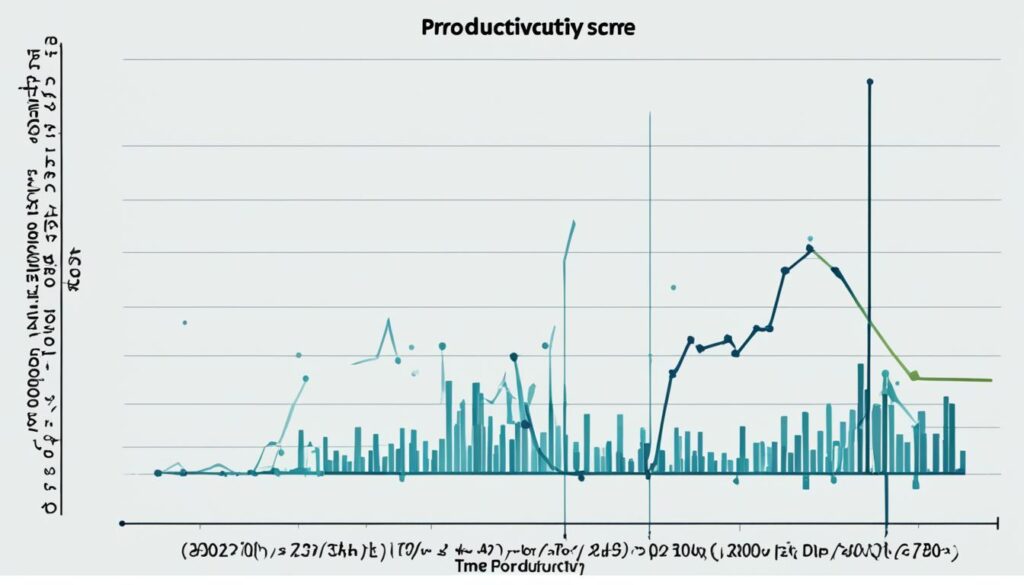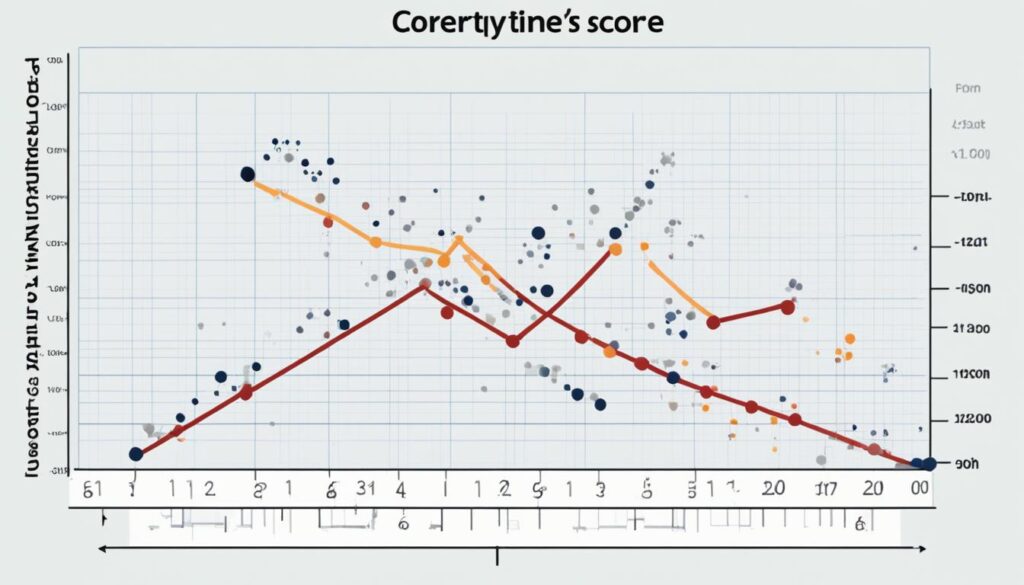Boost Your Success: Measure Productivity Effectively

Are you truly maximizing your team’s potential? Are you on top of your company’s productivity game? If you want to achieve unprecedented success, it’s time to ask yourself these crucial questions:
How do you measure productivity? What are the most effective ways to track and analyze productivity metrics? And more importantly, how can you increase productivity efficiency in your organization?
Unlock the potential of your team and take your business to new heights by mastering the art of productivity measurement. In this comprehensive guide, we’ll explore the key strategies, tools, and insights to help you measure and boost productivity effectively. Discover the secrets that top-performing companies rely on to succeed.
Key Takeaways:
- Measuring productivity is essential for success in any organization.
- Productivity metrics provide insights into efficiency and effectiveness.
- Tracking productivity helps identify areas for improvement.
- Boosting productivity leads to enhanced efficiency and customer satisfaction.
- Strategies like goal setting and embracing digital transformation can increase productivity.
What is Productivity Score?
In today’s fast-paced business environment, measuring the efficiency and effectiveness of your workforce is crucial for success. One way to gauge this is through the use of a productivity score. A productivity score is a metric that provides insights into how well your employees are performing their tasks, meeting deadlines, and contributing to the overall goals of your business.
When calculating the productivity score, several factors are taken into account, including completed tasks, time management, collaboration, and overall output. By evaluating these key performance indicators, you can gain a deeper understanding of the productivity levels within your workplace.
Why is the productivity score important? It serves as an essential tool for businesses to track their workforce’s efficiency and effectiveness. By monitoring and analyzing the productivity score, you can identify areas that require improvement and implement strategies to enhance productivity.
Now, let’s take a closer look at how to measure and calculate worker productivity scores in the next section.

Factors Considered in Productivity Score Calculation
| Factors | Description |
|---|---|
| Completed Tasks | The number of tasks completed by an individual or team within a given period of time. |
| Time Management | The ability to allocate time efficiently to different tasks and meet deadlines. |
| Collaboration | The level of teamwork and coordination among employees in achieving common goals. |
| Overall Output | The quantity and quality of work produced by an individual or team. |
How to Measure Worker Productivity Score?
In order to effectively measure the productivity of your workforce, it is important to consider various key performance indicators (KPIs) that provide valuable insights into their performance. By evaluating these quantifiable data points, you can gain a deeper understanding of how well your employees are completing tasks, meeting deadlines, utilizing resources, and delivering results.
Key Performance Indicators
When measuring worker productivity scores, it is essential to evaluate key performance indicators that accurately reflect their performance and contribution to the organization. Some of the key KPIs to consider include:
- Completed tasks: Assess the number and quality of tasks completed by each employee.
- Meeting deadlines: Evaluate employees’ ability to meet project timelines and deadlines.
- Utilization of resources: Determine how effectively employees utilize available resources to accomplish tasks.
- Response times: Measure the speed and efficiency of employees’ response to customer inquiries or internal requests.
- Infrastructure usage: Evaluate the efficiency and effectiveness of employees’ usage of company infrastructure and tools.
- Customer satisfaction ratings: Assess customer satisfaction levels through ratings and feedback.
- Revenue generated per employee: Measure the revenue or value generated by each employee.
By carefully analyzing these KPIs, you can gain a comprehensive understanding of your workers’ productivity levels and identify areas for improvement.

How to Calculate Employee Productivity Scores?
Calculating employee productivity scores is a crucial step in understanding the efficiency and effectiveness of your workforce. By measuring and analyzing productivity metrics, businesses can gain insights into individual and team performance, identify areas for improvement, and facilitate growth. Here’s a step-by-step guide on how to calculate employee productivity scores:
1. Define Productivity Metrics
Start by clearly defining the productivity metrics that align with your organization’s goals and objectives. These metrics should reflect key performance indicators (KPIs) that measure the effectiveness and efficiency of employee contributions.
2. Gather Relevant Data
Collect the necessary data to evaluate employee productivity. This may include data on completed tasks, project milestones, time spent on specific activities, and other performance-related indicators.
3. Set Benchmarks
Establish benchmarks or performance standards against which you can compare individual and team productivity scores. These benchmarks provide a reference point for evaluating performance and identifying opportunities for improvement.
4. Calculate Individual Productivity
Use a productivity score formula or equation to calculate the individual productivity score for each employee. The formula may vary depending on the specific metrics and goals of your organization. Consider factors such as output volume, quality, timeliness, and resource utilization.
5. Provide Feedback and Improvement Opportunities
Once you have calculated the productivity scores, provide feedback to employees to help them understand their performance and areas for improvement. Offer actionable suggestions and opportunities for growth, allowing individuals to enhance their productivity over time.
Calculating employee productivity scores is an ongoing process that enables organizations to monitor performance, drive continuous improvement, and maximize productivity at all levels. By utilizing data-driven insights and providing feedback, businesses can empower their workforce to consistently deliver exceptional results.

Importance of Measuring Employee Productivity Score
Measuring your employees’ productivity score plays a vital role in various aspects of your organization’s success. Let’s take a closer look at why it is important:
Performance Evaluation
By measuring employee productivity scores, you can conduct fair and objective performance evaluations. This enables you to identify top performers, recognize their achievements, and provide constructive feedback to employees who may need improvement. It ensures that performance evaluations are based on quantifiable data rather than subjective opinions, promoting transparency and fairness in your organization’s evaluation processes.
Resource Allocation
Accurate measurement of employee productivity scores helps you effectively allocate resources within your organization. By identifying team members who consistently perform at high levels and produce excellent results, you can assign them to critical projects or strategic initiatives. Conversely, if you identify employees who may be experiencing productivity challenges, you can offer targeted training or support, ensuring resources are utilized optimally.
Continuous Improvement
Measuring employee productivity scores empowers you to drive continuous improvement within your organization. By analyzing the productivity scores, you can identify areas where performance may be lagging and implement strategies to enhance efficiency and effectiveness. This data-driven approach to improvement allows you to track progress over time, set realistic goals, and implement targeted interventions to continuously enhance productivity and deliver better results.
Decision Making
Informed decision making is crucial for the success of any organization. By measuring employee productivity scores, you gain valuable insights that can support strategic decision making. These insights enable you to make data-driven decisions regarding workforce planning, performance management, resource allocation, and goal setting. By leveraging productivity data, you can make informed decisions that align with your organization’s goals and objectives.
To effectively measure employee productivity scores, organizations often utilize a range of techniques, including key performance indicators (KPIs), performance metrics, and data analysis. By employing these methods, you can establish a comprehensive understanding of your employees’ productivity and take proactive steps to drive success.
| Benefits of Measuring Employee Productivity Score |
|---|
| Objective performance evaluations |
| Effective resource allocation |
| Continuous improvement initiatives |
| Informed decision-making processes |
Importance of Boosting Productivity Score
Boosting the productivity score of your team is essential for achieving enhanced efficiency, timely task completion, improved quality of work, stronger collaboration, and enhanced customer satisfaction. When your team operates at peak performance levels, it maximizes output in minimum time, ensuring tasks are completed efficiently and deadlines are met without compromising on quality.
A high productivity score signifies that your team is consistently maintaining high-quality standards, effectively collaborating, and delivering excellent customer service. It reflects the ability to handle tasks efficiently, optimize work processes, and utilize resources effectively, resulting in improved productivity.
By implementing strategies to boost productivity and maintaining a high productivity score, your team will achieve enhanced efficiency in task execution, ensuring timely completion while meeting or exceeding customer expectations. This increased efficiency will lead to improved overall work quality, as tasks are completed with precision and attention to detail.
In addition to enhanced efficiency and improved quality of work, boosting productivity score promotes stronger collaboration within your team. A high productivity score indicates that team members are effectively communicating, working together towards common goals, and utilizing their collective strengths to produce exceptional outcomes.

Enhanced customer satisfaction is another significant benefit of boosting productivity score. With improved efficiency, timely task completion, and high-quality output, your team is better equipped to meet customer expectations, deliver products or services on time, and provide exceptional experiences. This, in turn, leads to increased customer loyalty, positive word-of-mouth, and repeat business.
In conclusion, achieving a high productivity score is crucial for maximizing efficiency, ensuring timely task completion and high-quality work, promoting stronger collaboration, and enhancing customer satisfaction. By implementing strategies to boost productivity, you can unlock your team’s full potential and propel your organization towards greater success.
Strategies to Boost Productivity Score at the Workplace
Boosting productivity score is crucial for achieving success in your organization. By implementing effective strategies, you can optimize your workforce’s efficiency and drive better outcomes. Here are some actionable strategies to boost your productivity score:
1. Establish Clear Goals and Priorities
Setting clear goals and priorities helps align your team’s efforts and focus on what matters most. Clearly define objectives and communicate them to your team, ensuring everyone understands the expected outcomes. This clarity enables individuals to prioritize tasks effectively, contributing to overall productivity.
2. Embrace Digital Transformation
The digital era has revolutionized the way we work. Embrace technology tools and solutions that can streamline processes and automate repetitive tasks. By leveraging digital tools like project management software, collaboration platforms, and communication tools, you can enhance efficiency and collaboration, leading to improved productivity scores.
3. Streamline Document Collaboration
Efficient document collaboration is essential for smooth workflows. Implement cloud-based document collaboration platforms that allow multiple team members to collaborate on documents simultaneously. This streamlines the review and approval process, reduces errors, and ensures version control, enabling teams to work seamlessly and boost productivity.
4. Utilize Task Management Software
Task management software helps individuals and teams stay organized and focused on their priorities. Choose a task management tool that aligns with your workflow and provides features like task assignment, deadlines, progress tracking, and notifications. By centralizing tasks and monitoring progress, you can optimize productivity and ensure timely completion of tasks.
5. Take the SMART Approach
The SMART approach to goal setting is a powerful method to boost productivity. SMART stands for Specific, Measurable, Achievable, Relevant, and Time-bound. When setting goals, make sure they are well-defined, quantifiable, attainable, aligned with your objectives, and have clear deadlines. This approach empowers individuals to focus on actionable goals and track their progress effectively.
Implementing these strategies to boost your productivity score can have a significant impact on your overall efficiency and performance. By setting clear goals, embracing digital transformation, streamlining document collaboration, utilizing task management software, and taking the SMART approach, you can create a productive work environment and drive success.
| Strategy | Benefits |
|---|---|
| Establish Clear Goals and Priorities |
|
| Embrace Digital Transformation |
|
| Streamline Document Collaboration |
|
| Utilize Task Management Software |
|
| Take the SMART Approach |
|
Conclusion
In conclusion, measuring productivity and boosting productivity score is essential for achieving success in any organization. By effectively measuring productivity using various key performance indicators, businesses can gain valuable insights into their workforce’s efficiency and effectiveness. This allows for better resource allocation, continuous improvement, and informed decision-making.
Implementing strategies to improve productivity, such as setting clear goals and priorities, embracing digital transformation, and utilizing productivity tools, can significantly impact the overall performance of the organization. By tracking productivity metrics and analyzing productivity scores, businesses can identify areas for improvement, enhance efficiency, meet deadlines, and improve the quality of work.
Furthermore, fostering collaboration among employees and prioritizing customer satisfaction can lead to increased productivity efficiency. With a strong productivity score, organizations can maximize output in minimum time, achieve timely task completion, maintain high-quality standards, deliver excellent customer service, and ultimately drive overall success.






